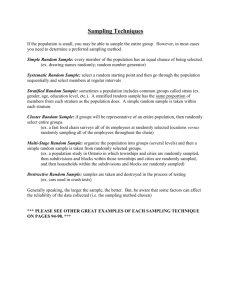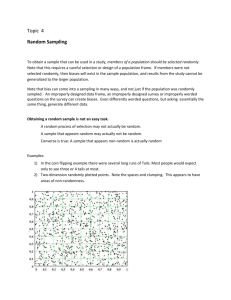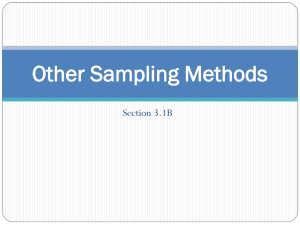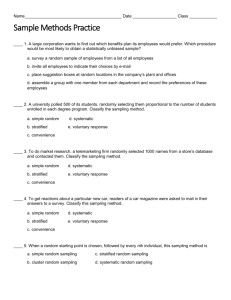Lesson 2.3
advertisement
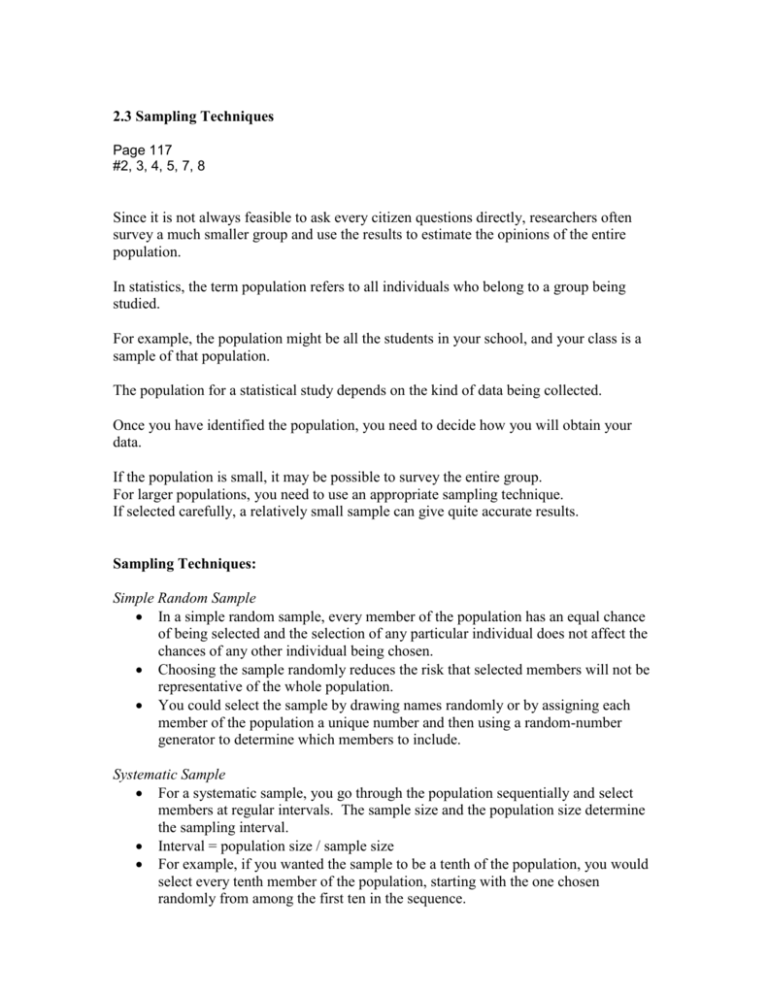
2.3 Sampling Techniques Page 117 #2, 3, 4, 5, 7, 8 Since it is not always feasible to ask every citizen questions directly, researchers often survey a much smaller group and use the results to estimate the opinions of the entire population. In statistics, the term population refers to all individuals who belong to a group being studied. For example, the population might be all the students in your school, and your class is a sample of that population. The population for a statistical study depends on the kind of data being collected. Once you have identified the population, you need to decide how you will obtain your data. If the population is small, it may be possible to survey the entire group. For larger populations, you need to use an appropriate sampling technique. If selected carefully, a relatively small sample can give quite accurate results. Sampling Techniques: Simple Random Sample In a simple random sample, every member of the population has an equal chance of being selected and the selection of any particular individual does not affect the chances of any other individual being chosen. Choosing the sample randomly reduces the risk that selected members will not be representative of the whole population. You could select the sample by drawing names randomly or by assigning each member of the population a unique number and then using a random-number generator to determine which members to include. Systematic Sample For a systematic sample, you go through the population sequentially and select members at regular intervals. The sample size and the population size determine the sampling interval. Interval = population size / sample size For example, if you wanted the sample to be a tenth of the population, you would select every tenth member of the population, starting with the one chosen randomly from among the first ten in the sequence. A systematic sample is a form of random sample because the ordering of the population (usually alphabetical) is assumed to be random in terms of likely opinions and responses. Thus, picking out every nth person should give a cross section of opinion. Stratified Sample Sometimes a population includes groups of members who share common characteristics, such as gender, age, or education level. Such groups are called strata. A stratified sample has the same proportion of members from each stratum as the population does. With a stratified sample, members of each subgroup are randomly selected in proportion to the subgroup’s size. More Sampling Techniques: Cluster Sample: If certain groups are likely to be representative of the entire population, you can use a random selection of such groups as a cluster sample. For example, a fast-food chain could save time and money by surveying all its employees at randomly selected locations instead of surveying randomly selected employees throughout the chain. With a cluster sample, a few representative subgroups are selected at random and the entire population of those subgroups is surveyed. Multi-Stage Sample: Uses several levels of random sampling. If, for example, your population consisted of all Ontario households, you could first randomly sample from all cities and townships in Ontario, then randomly sample from all subdivisions or blocks within the selected cities and townships, and finally randomly sample from all houses within the selected subdivisions or blocks. Voluntary-Response Sample: The researcher simply invites any member of the population to participate in the survey. The results from the responses of such survey can be skewed because the people who choose to respond are often not representative of the population. Call-in shows and mail-in surveys rely on voluntary-response samples. Convenience Sample: Often, a sample is selected simply because it is easily accessible. While obviously not as random as some of the other techniques, such convenience samples can sometimes yield helpful information. EXAMPLE For a provincial test of the grade 9 mathematics curriculum: Stratified sample: randomly selecting a certain number of students from each school across the province (strata referring to categorizing the data, based on characteristics, in order to select these certain number of students). Cluster sample: randomly selecting a few schools and all the grade 9 students in those schools. *** Points of Consideration: It is easier to survey a smaller group than an entire population. Sampling techniques have been designed to make sure the responses of the sample usually reflect those of the population. If the sample is too small, it may not accurately indicate the opinions of the population. It may also be difficult to ensure that an appropriate sampling technique is used. Data that you collect yourself for a particular purpose are called primary data. Data that are collected by others and reused by you for a different purpose are called secondary data. When studying a group of people or information, the entire group is referred to as the population. However, when collecting data, it is often unreasonable to collect information from everyone or everything involved. For this reason, a carefully selected group is chosen instead. This is called a sample. Sampling is used to collect some data in the census of Canada. In order for any sample to accurately reflect the group, the sampling method must be such that every person or thing in the population has an equal chance of being selected for the sample. Otherwise, a bias can be introduced. There are several types of random sampling methods that give each person or thing the same opportunity to be selected. Choosing the appropriate sampling method depends on a number of factors, such as the nature of the population, cost, convenience, and reliability. A carefully selected sample can provide accurate information about a population. Selecting an appropriate sampling technique is important to ensure that the sample reflects the characteristics of the population. Randomly selected samples have a good chance of being representative of the population. The choice of sampling technique will depend on a number of factors, such as the nature of the population, cost, convenience, and reliability.


